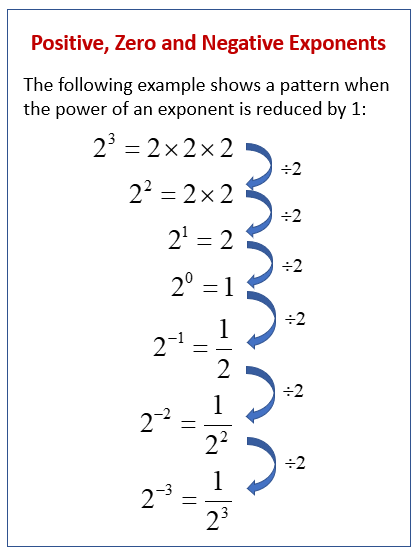Positive, Zero and Negative Exponents
Related Topics:
More Lessons for Grade 6
Math Worksheets
Videos, worksheets, stories and songs to help Grade 6 students learn how to evaluate positive, zero and negative exponents.
Exponents
- Positive Exponents:
Definition: A positive exponent indicates how many times a base number is multiplied by itself.
Example: 2³ = 2 × 2 × 2 = 8
Meaning: It represents repeated multiplication. - Zero Exponents:
Definition: Any non-zero number raised to the power of zero equals 1.
Example: 80 = 1, 170 = 1
Important Note: Some mathematicians define 00 = 1, whereas others leave it undefined. - Negative Exponents:
Definition: A negative exponent indicates the reciprocal of the base raised to the positive version of that exponent.
Example: 2⁻² = 1/2² = 1/4
(4/3)−2 = (4/3)2 = 16/9
Meaning: It represents repeated reciprocal of a number.
The following diagram shows the pattern when the power of an exponent is reduced by 1. It also gives an idea why a-b = 1/ab and why a0 = 1. Scroll down the page for the video that will explain this further.

Exponent Worksheets
Practice your math skills with the following exponent worksheets.
Online & Printable Exponent Worksheets
Positive and Negative Exponents
Positive exponents are easy, but what happens when you have zero for the exponent? Or even worse, a negative number?
Pattern for zero and negative exponents
Example:
53 = 5 • 5 • 5
52 = 5 • 5
51 = 5
50 = 1
5-1 = 1/5
5-2 = 1/52
5-3 = 1/53
Zero and negative exponent properties
Zero Exponent Property
Any quantity raised to the zero power equals 1.
Negative Exponent Property
a-n = the reciprocal of an
a-n = 1/an
Definitions, covers negative exponents and zero as an exponent
Negative Exponent Intuition
Intuition on why a-b = 1/ab (and why a0 = 1)
Try out our new and fun Fraction Concoction Game.
Add and subtract fractions to make exciting fraction concoctions following a recipe. There are four levels of difficulty: Easy, medium, hard and insane. Practice the basics of fraction addition and subtraction or challenge yourself with the insane level.

We welcome your feedback, comments and questions about this site or page. Please submit your feedback or enquiries via our Feedback page.